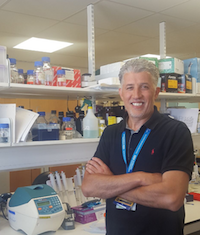Members Login

Channels
Special Offers & Promotions
Asthma Study Provides
Research led by University of Leicester paves way for developing new treatments
 ‘The study demonstrated for the first time that a protein called PP5 was significantly upregulated in the lungs of severe asthmatic patients compared to healthy controls. We are extremely excited by this paradigm shift observation.’ - Dr Yassine Amrani, University of Leicester
‘The study demonstrated for the first time that a protein called PP5 was significantly upregulated in the lungs of severe asthmatic patients compared to healthy controls. We are extremely excited by this paradigm shift observation.’ - Dr Yassine Amrani, University of Leicester
A new study led by the University of Leicester to understand how to improve the health of severe asthma patients has made a breakthrough finding.
Researchers have described their discovery as a ‘paradigm shift’ in understanding the life-threatening condition.
The international team from the Department of Infection, Immunity and Inflammation, University of Leicester, and the Department of Pharmaceutical Sciences, Jefferson School of Pharmacy, Thomas Jefferson University, discovered the presence of increased amounts of a protein – called PP5 – in the lungs of severe asthma patients.
They found that PP5 blocks the effects of the best medicines in improving the condition.
This now provides researchers with a target in order to try and help improve the symptoms of the condition in sufferers. The team has published their findings in the journal Allergy- the European Journal of Allergy and Clinical Immunology.
The lead author of the study, Dr Yassine Amrani, Associate Professor in Respiratory Immunology at the University of Leicester, said: “The goal of this study was to provide mechanistic insight into the reasons why our best anti-asthma drugs called ‘corticosteroids’ provide little clinical benefit in patients with a severe form of the disease. This is an unmet clinical need.
“Because of the lack of response to treatment, these severe patients have a very poor quality of life, suffer from recurrent asthma attack and are more likely to be hospitalised and to possibly die from their disease. Severe asthma poses a veritable therapeutic challenge for medical researchers in the field.”
The researchers first performed test tube experiments using cells from healthy and severe asthma patients isolated using bronchoscopy to identify the proteins that interfere with the beneficial action of corticosteroids in the lungs. This type of laboratory experiment allows the team to make conclusions about cause and effect at the cell level.
The study also validated the test tube findings by observing the presence of PP5 in people. The researchers looked at whether these inhibitory proteins were abnormally expressed in the lungs of severe patients. The team is interested in lung cells because they are the first to encounter the anti-asthma drugs when given as inhalers.
Dr Amrani said: “The study demonstrated for the first time that a protein called PP5 was significantly upregulated in the lungs of severe asthmatic patients compared to healthy controls. The test tube study allowed us to show that this protein was playing a key role in suppressing the anti-inflammatory action of corticosteroid, thus identifying this protein as a potential new player in reducing patients’ response to corticosteroid therapy.”
Dr Amrani added that the basic mechanisms explaining the reduced therapeutic response to corticosteroids in severe asthma have not been clearly defined.
Dr Amrani said: “Previous studies by experts in this field have provided some possible mechanisms but were done mostly in non-lung cells. The originality of our work is demonstrated in that the blunted response to therapy in severe asthma may derive from a reduced sensitivity of key lung structural cells such as the airway muscle tissue which is responsible for the acute asthma attacks via their ability to narrow the airways. We provide evidence that the airway muscle tissue behaves like an inflammatory cell that is capable of producing different asthmatic factors known to be involved in severe asthma.”
The researchers say that their study shows that some severe asthma patients - despite being compliant to their treatment - may fail to properly benefit from their corticosteroid therapy because of the presence of heightened inhibitory signals driven by this protein called PP5 which blunts patients’ response to their best medicine.
Understanding the mechanisms driving this abnormal expression of PP5 in severe asthma could lead to novel treatments.
Dr Amrani added: “We are extremely excited by this paradigm shift observation as a recent study from a different group provided additional evidence for a role of PP5 in blunting corticosteroid response in asthma. Whether assessing the expression levels of PP5 could serve as a biomarker to determine patients’ response to therapy needs to be further explored.”
The study was performed in laboratories part-funded by ERDF #05567 and supported by the National Institute for Health Research (NIHR) Leicester Respiratory Biomedical Research Unit (BRC) and by Department of Health and National Institutes of Health grants R01 HL111541 (OT).
The National Institute for Health Research (NIHR) Leicester Respiratory Biomedical Research Unit (BRU) is a partnership between University of Leicester and University Hospitals of Leicester NHS Trust. In 2012 the respiratory research department became part of a multi-million pound government investment by the NIHR, to become one of only twenty BRU's within England. The Unit will focus on promoting the development of new and effective therapies for the treatment of respiratory diseases including severe asthma and chronic obstructive pulmonary disease (COPD). The funding has allowed the development of a specially designed unit including clinical space and specialist team allowing first class investigations into lung disease.
- Allergy- the European Journal of Allergy and Clinical Immunology. To cite this article: Chachi L, Abbassian M, Gavrila A, Alzahrani A, Tliba O, Bradding P, Wardlaw AJ, Brightling C, Amrani Y. ‘Protein phosphatase 5 mediate scorticosteroid insensitivity in airway smooth muscle in patients with severe asthma’. Allergy 2016; DOI: 10.1111/all.13003.
more about university of leicester
Media Partners


